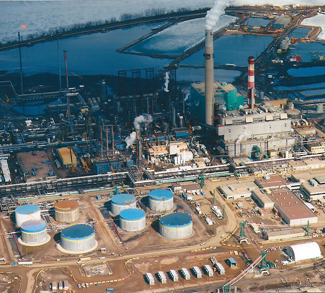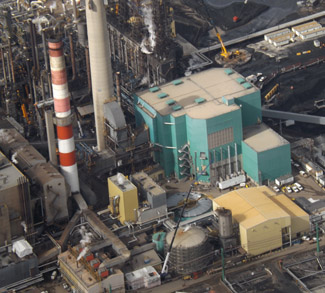As I write this article, a horrific forest fire has forced the entire municipality of Fort McMurray, Alberta to evacuate their homes and businesses. As someone with a connection to Fort McMurray and someone who understands its importance to Canada’s oil sands, my heart goes out to all the people that have left everything behind to seek safety. Fort McMurray and Canada’s oil sands formed the base of my intrigue into oil & gas analysis and helped shape my career. I ask whoever is reading this, has the capacity to donate, and has benefitted from the oil sands in any way to donate to the Canadian Red Cross Alberta Fires Appeal. I have never really donated to a specific cause, but Fort McMurray has a lasting impact in my life and I am happy to provide monetary assistance.
Suncor: King of Canada’s Oil Sands
Canada’s oil sands are the third largest oil deposit in the world behind Saudi Arabia and Venezuela. The largest oil sands producer in Canada, Suncor Energy (SU), has managed to dominate market share in oil sands mining, in-situ, and synthetic crude oil operations.
Suncor began oil sands mining operations with the Millennium Mine in 1967, currently known as Suncor’s Base Operations, with initial production capacity of 294,000 barrels per day. Capacity at Base Operations is now the largest oil sands mine, with 350,000 barrels per day of capacity. Then, in 2004, Suncor began in-situ oil sands operations at its Firebag facility with capacity to produce 35,000 barrels per day. Unlike the surface mining of Suncor’s Base Operations, Firebag extracts oil underground through the injection of steam, heating and liquefying oil underground, and pumping oil back up to the surface. Today, the Firebag in-situ project has 203,000 barrels per day of capacity – the largest in-situ project operating in Canada’s oil sands.
Suncor Consolidating Oil Sands Production
Suncor began its buying spree in the depressed oil environment of September 2015, when the company purchased a 10% stake from its joint venture partner at the Fort Hills oil sands mining project. The purchase of Total SA’s (TOT) stake cost Suncor $310 million and gave the company control of 50.8% of the Fort Hills mine, with expected working interest capacity of 91,000 barrels per day in 2017.
The Total SA deal was just the beginning for Suncor – the company shifted its focus from oil sands mining to synthetic crude oil production. Suncor owned a 12% non-operating stake in Canada’s largest synthetic crude oil project, Syncrude Canada, with capacity to produce 350,000 barrels per day of synthetic crude oil. Oil sands oil is extracted in the form of a heavy viscous oil called bitumen that is either blended with a lighter oil or upgraded through facilities similar to Syncrude Canada’s synthetic oil operations; this ensures blended or upgraded bitumen flows smoothly through pipelines.
Most of Canada’s oil sands bitumen production is blended with a light oil mainly supplied by an imported ultra-light US shale oil called condensate. For every 10 barrels of bitumen, 3 barrels of condensate are required for blending. The blended product is referred to as Western Canadian Select (WCS) oil and it trades at a significant discount to lighter synthetic oil and the US benchmark for light oil referred to as WTI. The fact is that even when blended, WCS is a heavier oil and more difficult for refiners to refine over lighter crudes; thus, lighter crudes like WTI, condensate, and synthetic crude trade at a premium to WCS.

***The lighter the oil, the higher the oil’s API, and the easier it is for refiners to crack oil into lighter petroleum products like gasoline, diesel, and distillates. Condensate, also known as Pentanes Plus, is used primarily for blending with fuel/oil.***
The alternative to blending heavier oil and a way to extract a higher priced crude from Canada’s oil sands is to produce synthetic crude oil by preliminarily refining heavy oil to a lighter product similar to the US benchmark WTI. The cost to refine heavy oil into synthetic crude oil can be an additional $7-$16 per barrel compared to blending bitumen with light oil and is one of the reasons why synthetic crude oil often trades at a wide premium to WCS.

Suncor’s synthetic crude oil costs are relatively low when compared to its other Syncrude Canada partners. As of the first quarter of 2016, Suncor has managed to keep its synthetic crude oil operating costs at $7.10 per barrel greater than its WCS-priced Canadian heavy oil production costs. The additional $7.10 costs to Suncor for the production of synthetic crude oil is much lower than the spread they receive between refining and selling higher priced synthetic crude oil compared to blending heavy oil and selling at lower WCS prices. Put another way, their cost of production is lower than the synthetic premium shown in the chart above.

At the end of 2015 and into early 2016, Suncor made a big bet on Syncrude Canada with the purchase of Canadian Oil Sands (COS): Syncrude Canada’s largest partner. The acquisition of Canadian Oil Sands cost Suncor $6.6 billion in March 2016 and Suncor was now producing a quarter of all of Canada’s oil sands production.

After closing the purchase of Canadian Oil Sands in March 2016, Suncor bought an additional 5% stake in Syncrude Canada from Murphy Oil (MRU) for $937 million, making Suncor the majority owner of Syncrude Canada.

Why Syncrude Canada? Why Now?
Suncor’s purchase of both Canadian Oil Sands and Murphy Oil stakes in Syncrude Canada are the cheapest entry points since upgrades made to Syncrude Canada in 2006.

Suncor purchased Canadian Oil Sands and Murphy Oil stakes in Syncrude at a 70% discount to the purchase price Sinopec piad for ConocoPhillips’ (COP) 9% stake in Syncrude in 2010, even though the current WTI price trades at a 40% discount to prices in 2010. Suncor’s plan is to use its operational expertise, scale of Syncrude operations, and improved performance of Syncrude Canada by operational partner Imperial Oil (IMO) and Exxon (XOM) to bring down costs over time. Suncor’s cost to produce synthetic crude oil is the lowest from the companies it acquired, and Suncor has made it clear that it is looking to improve efficiencies from its acquisition instead of seeking operational ownership.

While Suncor focuses on its own efficiencies, Imperial Oil and Exxon have greatly improved operational efficiency at Syncrude Canada into 2016. Every year since 2010, operational issues have plagued Syncrude operations, bringing utilization rates down to 70% from over 84%. At the time Imperial Oil and Exxon took operational control over Syncrude Canada in 2006, on a 10-year management agreement, Syncrude Canada faced issues with its refining cokers, sulphur processing units, water treaters, and boilers. After 10 years of management, Imperial Oil and Exxon have improved operations and learned from mistakes which has given the companies a deeper understanding of Syncrude operations and, thus, able to handle past issues with more efficiency.
Currently Syncrude operations are running at their highest rates since 2010 and Suncor has reaffirmed that these high utilization rates are expected to continue into the future. Suncor, with its majority ownership, will work with Imperial Oil and Exxon to improve operations and keep utilization rates near their current level.

With increased utilization of Syncrude facilities, Canada’s conventional oil exports are increasingly being made up of synthetic crude oil. In 2011 synthetic crude oil was the 4th largest conventional oil export from Canada making up 20% of exports. As of the first quarter of 2016 synthetic crude oil became the 2nd largest conventional oil export from Canada, climbing to 26% of exports.

Suncor – The Closest Thing to a Canadian National Oil Company
Suncor has become synonymous with Canada’s oil sands as the company controls almost 30% of all oil sands mining and in-situ production capacity directly or through partnerships. On top of unprocessed oil sands production, Suncor’s acquisition of Canadian Oil Sands and Murphy Oil’s Syncrude share has increased Suncor’s ownership control of synthetic crude oil operations to over 60% of all upgraded oil capacity coming out of Canada’s oil sands.
Suncor has used the 2015/2016 down market in oil prices to strategically consolidate its market share of Canada’s oil sands. With 46% of Suncor’s operating cash flows generated from Suncor’s refining operations and the rest generated from upstream exploration & production and oil sands businesses, Suncor’s cash flows are much less volatile relative to oil prices. While the price of oil fell 48% from 2014, Suncor’s operating cash flow fell by only 22%. The lower volatility of cash flows and relatively low debt levels gave Suncor the strength the company needed to start building market share in Canada’s oil sands. Suncor has become one of the first examples of how large companies with a healthy balance sheet and stable operating cash flow can take advantage of today’s market to gain a larger market share, essentially controlling the 3rd largest oil reserve in the world: Canada’s oil sands.




